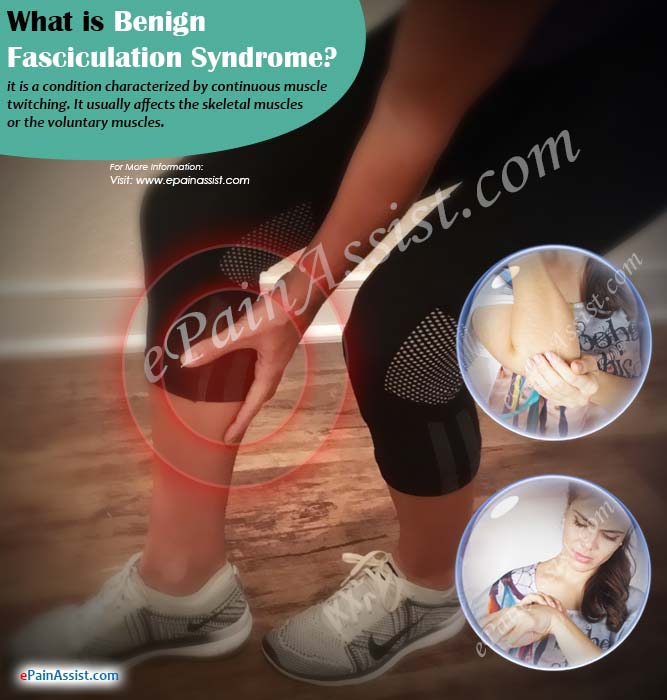Benign fasciculation syndrome is a neurological disorder which is not very severe in nature. In general neurological disorders are diseases that affect the nervous system, the spinal cord and the brain. Neurological symptoms are not always associated with a definitive disease. Certain neurological symptoms may develop occasionally in a healthy individual which may not be linked to a specific neurological disease. These include symptoms such as dizziness, headache, numbness, weakness, muscle twitches, cramps, pain, shakiness and tremors. Neurological symptoms may either cause mild discomfort or may be associated with life threatening disorders. Benign fasciculation syndrome, which is also known as ‘muscle twitching syndrome’ or ‘fasciculation syndrome’, causes rapid contraction and relaxation of the muscle. Let us learn about the symptoms, causes, diagnosis, treatment and prevention of the syndrome in detail.

What is Benign Fasciculation Syndrome?
Benign fasciculation syndrome is a condition characterized by continuous muscle twitching. It usually affects the skeletal muscles or the voluntary muscles. In some cases, these twitching may be associated with other underlying condition such as multiple sclerosis, spinal injury, amyotrophic lateral sclerosis etc. It presents itself as involuntary muscular movements in any parts of the body including hands, fingers, legs, back, eye lids etc. Very rarely, it affects the muscles of the tongue.
Symptoms of Benign Fasciculation Syndrome
The most obvious symptoms of benign fasciculation syndrome are muscle twitches. These muscle twitches are involuntary, continuous and present at rest. The muscles twitches usually improve with voluntary movement of the muscles. The symptoms generally last for a prolonged period of time and may reoccur in the same area or migrate to other locations. It has been noted that the muscle twitches worsens at night and generally exacerbates with stress. There may be intermittent period of symptom-free phases. Over a period of time, the muscle twitching becomes less intense and the symptom free period becomes more.
Other symptoms of benign fasciculation syndrome include:
- Anxiety: Anxiety is very commonly seen in association with benign fasciculation syndrome.
- Pain: In certain cases, muscle twitching is accompanied by pain, tenderness, and cramping over the area.
- Fatigue: This condition is often associated with fatigue, which in turn reduces the capacity to carry out physical activities efficiently.
- Other Symptoms: Numbness, tingling sensation, pins and needles sensation, muscle stiffness, exaggerated tendon reflexes.
Causes and Risk Factors of Benign Fasciculation Syndrome
The exact cause of benign fasciculation syndrome cannot be pinpointed. It can arise from muscular disorders or nerve-related disorders. There may be symptoms in areas away from the source of the disorder, making it difficult to pinpoint the exact source. The possible causes of benign fasciculation syndrome are listed below:
- Anxiety and Stress: It has been noted that the muscles twitches in benign fasciculation syndrome worsens with stress and anxiety.
- Side Effects of Drugs: Benign fasciculation syndrome can occur as a side effect of certain drugs such as anticholinergics like deimenhydrinate.
- Withdrawal Syndrome: Certain drugs such as opioids like morphine may elicit symptoms of benign fasciculation syndrome when stopped suddenly.
- Nutrient Deficiency as a Risk Factor of Benign Fasciculation Syndrome: Symptoms of benign fasciculation syndrome are noted in individuals with magnesium, calcium, potassium and other micro nutrient deficiency.
- Other Causes: Viral infections, Lyme disease, extreme exercising etc. can also lead to benign fasciculation syndrome.
Diagnosis of Benign Fasciculation Syndrome
A definite diagnosis of benign fasciculation syndrome is made after ruling out all other possible causes of muscle twitches such as Lyme disease, multiple sclerosis, Amyotrophic Lateral Sclerosis etc. A detailed case history is obtained followed by a detailed neurological examination. Physical examination is done to check for reflexes and hyperreflexia. Investigative studies such as EMG (electromyography) is done to study the nerve functioning. Other studies such as CAT scan, MRI and blood work may be done to exclude other possible causes.
How is Benign Fasciculation Syndrome Treated?
There is no definitive treatment for benign fasciculation syndrome; however, it has been noted that the following methods may provide relief based on the extent of the disorder:
- Stress management
- Anti- anxiety medication
- Relaxation techniques such as meditations, yoga, counselling etc.
Some other medications have also been beneficial in the management of benign fasciculation syndrome. These include:
- Dietary supplements like magnesium, calcium and potassium
- Anti- epileptic drugs like carbamazepine or phenytoin
- Quinine
- Propranolol
- Verapamil.
Conclusion
Benign fasciculation syndrome is a neurological disorder characterized by abnormal involuntary muscle twitches. The condition as such is not severe, but the continuous muscle contraction and relaxation can cause irritation and annoyance in the individual. Quite often the condition is misdiagnosed as Amyotrophic Lateral Sclerosis due to similarity in symptoms. Besides the muscle twitches, other symptoms include muscle cramps, fatigue, anxiety, tingling sensation, numbness etc. Benign fasciculation syndrome may present itself as intermittent phases of muscle twitches and symptom-free phases. Diagnosis needs to be done by an experienced neurologist. Treatment modality for benign fasciculation syndrome includes anti-anxiety mediations, stress management, dietary supplements and drugs such as carbamazepine, phenytoin, quinine, propranolol, verapamil etc. With proper medication and stress management techniques, benign fasciculation syndrome can be managed easily.
Also Read:
